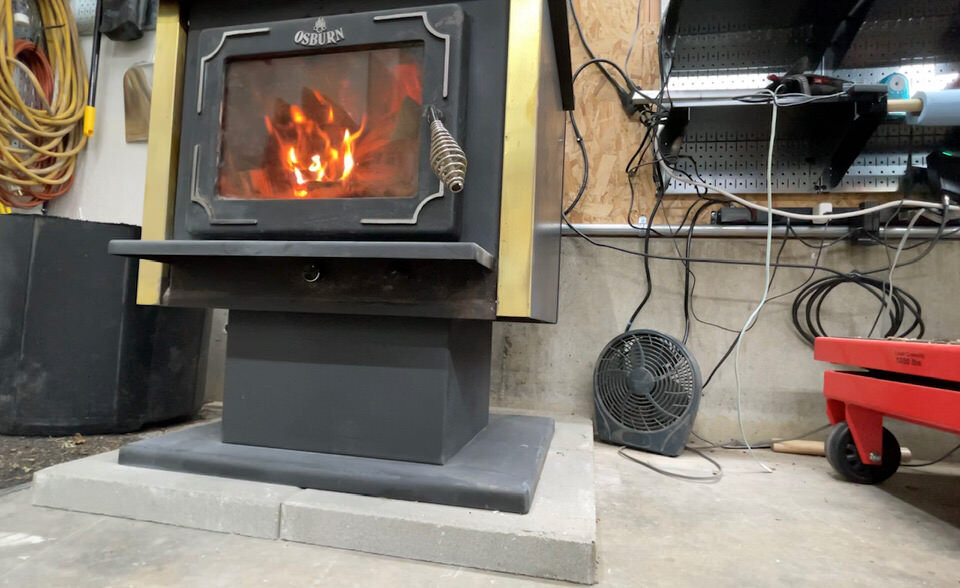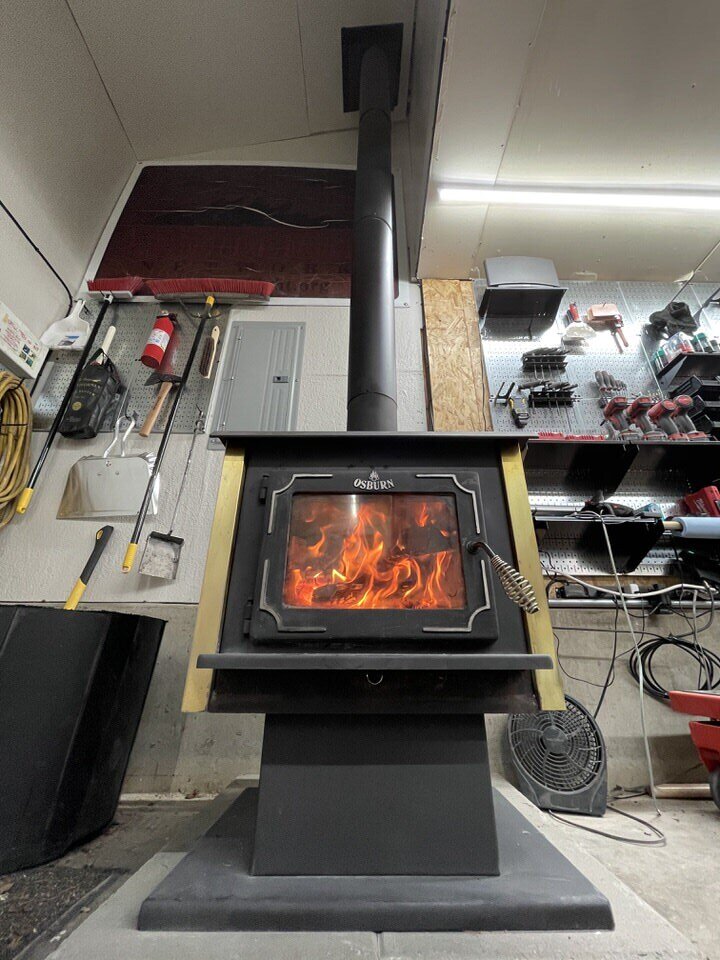Wood Stove VS Eco Electric Garage Heater
I am fortunate enough to have both an older steel wood stove and a modern eco-electric heater in my shop. Most people would generally opt for just one or the other, though. So which one is best for your particular shop or garage? I'll break down all the essential stuff here. Then let you decide for yourself.
Shop Details: 1300 square feet with a partial wall separating the north end from the south end. The wood stove is located against the north wall. The electric heater is mounted in a central location near the east wall, 8' off the ground.
Wood Stove
Up Front Cost
Like most anything in your shop, this can vary widely. You might already have an old wood stove in a buddy's basement that he said you could have, so long as you move it. Or maybe you're considering purchasing one on Craigslist. There is no reason a stove in good repair won't provide you with a lot of heat, however, you might run into some problems installing it. To install a new wood stove (legally), it needs to be permitted. To get a permit, you need a modern "EPA approved" wood stove. Which that one in your buddy's basement almost certainly is not. This is at least the case in Oregon; Texas might give you a tax credit if you install a non-EPA stove for all I know. When looking at a house that had an old non-EPA wood stove, a realtor once told me that "there is no wood stove police." So take that for what it's worth. Just be aware that you are not only breaking the law if you decide to hook up a non-EPA stove, but you are also damaging the environment. Sorry if that sounded like my inner Portland just came out. I assure you, there is no judgment either way on my part. I am just giving you the facts.
New EPA approved wood stoves capable of heating 1000-3000 square feet will run anywhere from $1000-2500 or more. Just like anything, you also get what you pay for. A better stove will burn less wood and provide more heat. So get the best one you can afford.
Installation cost
I got a bit of sticker shock here. Who knew that it could be so expensive to run a little bit of pipe? It turns out the materials are not that cheap. My stove had to run 12' to the ceiling, make a slight bend, then run out the top of my roof another 5'. My professional installer used high-quality materials, black double-wall pipe, and a polished stainless section above the roof. Which alone cost $1700. His labor brought my total installation cost to $2400—a significant amount for most people.
Operating cost
My in-law is all set for wood. I am not.
This is where I figured I'd be on easy-street since I usually have a lot of wood cutoffs. I figured I would also get a pickup truck full of cheap wood somewhere to make up the difference. Which should probably last me a few years, right? Apparently, not so much. Wood stoves suck down A LOT of wood. At least mine does. It is not a modern, efficient one, but it is a pretty high-quality one, just a bit older. I found myself burning through week's worth of scraps in just a day or so. Then I got a full-sized pickup truck full of seasoned maple, which was about a ½ cord. I haven't gone through the maple yet, but I've put a pretty big dent in it. My wood stove installer told me I should expect to go through about 1.5 cords per season burning regularly. He also said to me that my system would work the best and last the longest if I only burn good dry wood—ideally hardwoods. Around here, a cord of dry hardwood will cost around $200, softwoods a bit less. This means I should expect to spend about $300/year for wood. Not to mention the time acquiring/stacking/splitting (if necessary). Not a ton of money, but certainly not free.
How well does it heat?
I tested both the wood stove and the electric heater by seeing how long it took them to heat the entire shop to 60 F. In my video, you can see the heating process and how gradual the wood stove heat was. But here I will cut to the chase. My well-insulated shop was 52 F in the morning. It took 1:45 to bring the entire shop up to 60 F. Although the area around the stove was a cozy 78 F by the time the far side of the shop reached 60. My shop could benefit from improved circulation through fans, though. It's fair to point out that 52 is also not that cold compared to much of the country. A non-insulated pole barn in North Dakota would probably have slightly different numbers than me. My tests were, however, consistent from the wood stove to the electric heater.
Once the stove was up to temp with a good bed of coals, it did an excellent job maintaining the heat all day. I was able to let the temp drop slightly near the stove without a noticeable drop on the far side of the shop. I credit the excellent insulation for this, though.
All in all, I love the heat from my wood stove. Most days, I can be down to a t-shirt by noon, which is pretty nice for winter woodworking.
Eco Electric Heater
I will only be discussing one brand of heater. It is the only one that I have direct experience with, so I make no claims that it is the world's greatest or most efficient heater. I am, however, very impressed with what I have seen. King Electric has been making heaters here in the USA for over 50 years. They are manufactured just north of me outside of Seattle, WA. They recently launched their new line of Eco-smart heaters. What makes a heater Eco-smart? I won't pretend to understand all the intricacies, but they explained it to me this way. It runs full power half the time and half power the rest of the time. There are some other little tricks in there too. But that's the gist of it. Oh, it is also compatible with Nest thermostats. If you want a little deeper dive into this company, hit them up here.
Up Front Cost
Since I am only discussing one particular brand of heater, I can be a little more specific when it comes to the upfront cost compared to the wood stove. King Electric makes heaters in a wide variety of sizes. Their more popular 240V units range from 5000-15000kw. The price for my unit was $1199. I opted for a 7500kw unit due to the small size of my electrical panel.
Installation cost
These electric heaters are significantly easier to install than any wood stove. They come fully assembled. You just need to choose your mounting position. Either on a ceiling or a wall. King Electric gives some guidelines on how high up they recommend you mount them. All it takes is a few bolts, and you are ready to wire it up. I am moderately capable regarding electrical, so I was able to handle it myself. All you have to do is hook up two hot wires and one ground. Just make sure the power is disconnected before getting started, though. This 240 stuff is no joke.
My cost was zero to install the unit. A competent electrician should be able to wire it up in less than an hour, though. So I would say installation cost shouldn't exceed $200. Assuming you already have 240 available. If you don't have 240, expect several hundred more to run that from your panel. Any self-respecting shop that requires a heater should already have 240, though.
Operating Costs
I consulted with King Electric and got some basic numbers for estimating the operating cost of one of their units. Since this unit runs at ½ power, half of the time, I estimated the cost at around 53 cents per hour that it is running. Based on 10 cents per KW hour. I came up with the following estimates based on my relatively mild climate in NW Oregon.
King electric heater mounted per their specs.
Four hours a day, $2.12 per day
22 days a month, $47 per month
Four months a year, $188 per season
I would say these are pretty conservative estimates on usage. Meaning, I believe most people running a full-time shop would run their heater more than this. So I would think it would be fair to estimate $300-500 per season for colder climates.
How Well Does an electric shop heater heat?
I performed the same test with the electric heater that I did with the wood stove. The morning temp in my shop the day following the wood stove test was the same, 52 F. Which was lucky for the purposes of this test.
The electric heater brought the temp of the entire shop up to at least 60 in 1.5 hours. Just a bit faster than the wood stove. However, the warmest part of the shop was only 62, opposed to the balmy 78 when the wood stove was cooking. So the electric heat worked a little faster and a little more evenly. Not very surprising, though. Since it has a powerful fan to help circulate the air.
The electric heater did a good job maintaining the 60 degrees all day, running for only around 3.5 hours the day of this test. My shop is well insulated on all sides, including the ceiling, which is hopefully the same in your shop or garage.
Summary, wood heat vs electric heat
Wood stove can generate some serious heat when its going like this.
The wood stove has a much higher initial cost: both purchasing the stove itself, permitting, and installation costs.
Both wood and eco-electric heat have similar operating costs assuming you are purchasing wood. If you get wood for free, don't forget the time commitment for cutting, stacking, and splitting.
Electric heaters are much easier to install. Anywhere you can get 240 power will work. Provided it is high enough off the ground.
Wood heat can get much warmer, and therefore be a much more comfortable shop to work in, particularly if you prefer a warmer workspace.
Electric heat draws a lot of amps from your panel. So choose your model carefully. Consider running a dedicated circuit for the heater.
The fan from the electric heater is a little loud. Not powertool loud, but fan-loud.
Electric heat can be left on to hold a specific temperature all night. Which can be helpful for temperature-sensitive projects like epoxy pours.
This electric heater can be hooked up to a Nest thermostat. So you can get the shop pre-heated prior to your arrival if desired.
Finally, I love my hybrid system and highly recommend running both wood and electric if possible. I will save wood scraps all spring and summer to hopefully offset some of the wood costs because there is nothing like working in a 70-degree shop in January.







